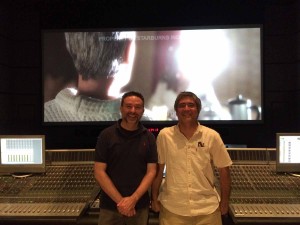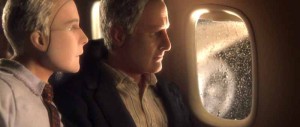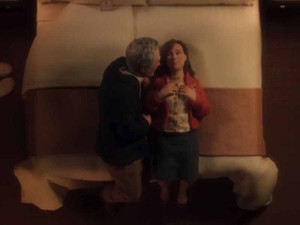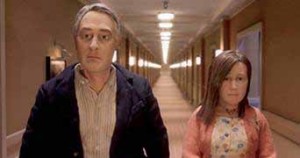
In what started as a stage play written by Charlie Kaufman, the stop-motion animated feature Anomalisa took over two years to finish before its Dec. 30 release date – even a successful Kickstarter campaign encouraged it to see the light of day. Directed by Kaufman and Duke Johnson, the story follows Michael Stone (David Thewlis), a respected author of How May I Help You Help Them?, who travels giving inspirational speeches to customer service professionals. A husband and father his life is crippled by the mundane until he meets Lisa Hessleman (Jennifer Jason Leigh), a socially awkward sales rep from Akron who could be the love of his life.
During postproduction supervising sound editors and rerecording mixers Christopher Aud and Aaron Glascock spent months working closely with the directors experimenting with ways of using resonating sound to paint a realistic audio palette against a nontraditional picture. “Going into the project, Charlie wanted to make sure we honored the way the film was made by keeping sounds handcrafted and revealing scenes in the same way they were doing it visually,” said Aud. “One of the first scenes we ever showed them was the cab scene. They were working on the project for a long time without really hearing anything so when we sat them down and played them the scene, it gave them the experience of what Michael’s environment could be like. I think that really opened them up to a whole world of possibilities they might not have even considered before.”

Both Aud and Glascock came into the picture late, but were still able to treat the story’s sound in an interesting and unique way. “I don’t want to sound silly, but you can’t do this type of project with just anyone. It takes a certain special someone like Aaron to pull it off,” said Aud. “In Anomalisa, the workflow wasn’t typical of what we do. I was doing sound design and so was Aaron. While Aaron inherited the dialogue, I recorded all the ADR. When we went to mix, I ended up taking all the sound effects and music, while Aaron took the dialogue and foley tracks. This way Aaron could really create those production sound elements right in front of him with the dialogue. In normal circumstances, I would have the foley and Aaron would have the music.” “Splitting sound elements apart happens in every movie, but we thought it was an added benefit to do it this way,” added Glascock.
Another nontraditional aspect to their technique was how they were able to ground the actor’s performances to the sound edit. “Normally in animation, you bring in one actor – they read lines and provide a range of emotions before you move on to the next actor. In this film, our three actors interacted with each other during the recording sessions,” explains Aud. “It wasn’t this totally sterile environment. They were all in the same room which allowed for a lot of storytelling to go inside the dialogue track. While there wasn’t any extra grounding life to it (inhales, exhales, small ad libs) it gave us the opportunity to honor and support those performances so that it was all very real. Then we came in and put everything in its proper place.”
 The foley track became a challenging aspect to the mix as well. “We did it all guerilla style,” said Glascock. “We recorded everything out in the real world as opposed to a foley stage to make it a little less polished and a little less shiny. We didn’t want the transition from one sound to another to be just with the faders so we recorded the sound to give it a sense of movement. Especially in places like the hallways, we wanted the sound to move through the microphone.”
The foley track became a challenging aspect to the mix as well. “We did it all guerilla style,” said Glascock. “We recorded everything out in the real world as opposed to a foley stage to make it a little less polished and a little less shiny. We didn’t want the transition from one sound to another to be just with the faders so we recorded the sound to give it a sense of movement. Especially in places like the hallways, we wanted the sound to move through the microphone.”
One key importance for them was to bring the nuances of real life into the track. “The sounds of a foley stage can be very surgical. We definitely thought that it would be the death knell to a story that was depicted this way,” Glascock noted. “We were very conscience of the level of craftsmanship happening on screen. The puppets had a certain look to them and weren’t visually perfect – you could see seams on their faces. It conveyed a sense of the human hand, so the audio we provided was always being criticized with the idea that it couldn’t be over crafted. It had to show natural flaws in the nature of the track so it would enhance what we are seeing.” One of those natural jumping off points happened in the edit room at Starburn. “The bay was in a less than perfect sound environment – every time the air conditioning would kick on the vent would rattle and make some noise,” said Aud. “That inspired us to make the unsettling sounds of the hotel room when Michael is all alone.”
 Throughout the entire process post created a set of rules to follow and in doing so were able to build a complete sonic world for the animated characters to live in. “Charlie and Duke were really making us think about what was happening. If what we were doing was wrong, all of it could have turned on a dime,” mentioned Glascock. “One of the things that was so inspiring for us was the first day we went down to Starburn Industries. We were able to see all the built sets and you could really get a sense of what it was going to take to do this. When you see something like that you know you have to step up your game and present something different.”
Throughout the entire process post created a set of rules to follow and in doing so were able to build a complete sonic world for the animated characters to live in. “Charlie and Duke were really making us think about what was happening. If what we were doing was wrong, all of it could have turned on a dime,” mentioned Glascock. “One of the things that was so inspiring for us was the first day we went down to Starburn Industries. We were able to see all the built sets and you could really get a sense of what it was going to take to do this. When you see something like that you know you have to step up your game and present something different.”
According to Aud, actor Tom Noonan, who voiced several characters, went above and beyond for the film as well. “When we were mixing and even going into our final mix, the edit wasn’t entirely locked. Editor Garret Elkins had created a base sound for us with limited resources for scenes like the bar and the lobby, but we needed to provide a bigger scope. Tom was gracious enough to come back in and record so much more walla for us. He ended up reading hundreds of miles cues for this film – he was so fantastic.”
 When entering the final mix, the team took the workflow in another direction as well. “It was definitely a different kind of approach,” said Glascock. “We mixed it quickly with them then took it away to refine at our suites in Warner Bros. Then we brought them back to stage to show them what we’ve done. We did that in chunks instead of hunkering down for weeks and going through everything at once.” Aud added, “We didn’t have any temp dubs or previews, we had to go with our guts. It was a very much an experiment. They knew we were trying to achieve something unusual so they were open to working in an unusual manner.”
When entering the final mix, the team took the workflow in another direction as well. “It was definitely a different kind of approach,” said Glascock. “We mixed it quickly with them then took it away to refine at our suites in Warner Bros. Then we brought them back to stage to show them what we’ve done. We did that in chunks instead of hunkering down for weeks and going through everything at once.” Aud added, “We didn’t have any temp dubs or previews, we had to go with our guts. It was a very much an experiment. They knew we were trying to achieve something unusual so they were open to working in an unusual manner.”
Both mixers had an amazing and memorable experience on the film. “You could see all the obstacles the filmmakers faced along the way. At one point, they weren’t even sure if they were going to make it to the finish line, but they kept fighting. Seeing that battle we felt the energy and we were going to do anything to make this story happen.”





